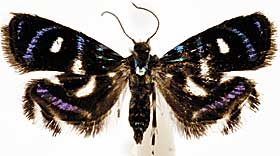  |
| HOME | THIS ISSUE | CALENDAR | GRANTS | BACK ISSUES | < BACK | NEXT > |
Mimicry an effective survival strategy for tiny metalmark mothby Cindy Weiss - April 2, 2007 | ||||
| You might call this a story that jumps out at you.
Jadranka Rota, a Ph.D. candidate in ecology and evolutionary biology, was conducting field research in Costa Rica on the behavior of metalmark moths in the genus Brenthia, when she and her adviser, David Wagner, noticed that “they do something weird.” Wagner, a professor of ecology and evolutionary biology, “said they looked like jumping spiders,” Rota recalls. Jumping spiders are just one step up the food chain from the metalmark moth. When a jumping spider sees a metalmark, it sees a meal. Yet the tiny moth can change the meal plan by whipping two of its four wings out to the sides and mimicking the most menacing posture of its spider predator, which raises and waves its forelegs in the air. The metalmark is among the world’s smallest moths, belonging to the group Microlepidoptera. With a wingspan of just 8 millimeters, it’s hard to believe the metalmark’s wing work would be effective. But it works. In experiments pitting the two in a Plexiglas arena, the metalmark faced down its nemesis time after time. In 77 trials to see if the spider would catch the moth, it was metalmark 72, jumping spider, 5. That was with spiders about the same size as the moths. In other experiments, a larger jumping spider entered the arena with the tiny metalmark. Although the results weren’t quite as good for the moth, they were still astounding: In 39 trials, it was metalmark 29, spider 10. It doesn’t take long to view a video of the control experiments with the moths that haven’t picked up the mimetic behavior. It took just seconds to gather the data. It’s one thing for a human roaming through the rainforest to mistake the metalmark for a jumping spider from a couple of meters away, as Rota did. But in the experiments with the two competitors mano a mano in an arena measuring just 10 x 5 x 4 centimeters, even the spider – known for its acute vision – was taken in by the metalmark’s ploy. Additional experiments showed that even when they didn’t catch the mimicking metalmarks, jumping spiders often responded to them with territorial displays indicating they mistook them for their own kind. That, from Wagner’s point of view as an entomologist, was the most remarkable result from the study – to see some spiders so duped that they engaged in territorial behavior. In nature, cases of predator mimicry, in which the prey avoids being eaten by directly mimicking its predator, “are both exceptional and rare,” wrote Rota and Wagner in a scientific paper. Rota and Wagner published their research in December in the inaugural online edition of the Public Library of Science journal, PLoS ONE. An e-journal was the ideal medium, because it allowed them to link viewers to videos of their experiments – metalmark vs. jumping spider. You have to see the confrontation to believe it, says Wagner, an expert on moths and author of Caterpillars of Eastern North America. While PLoS is a highly respected publication among biology researchers, the report immediately grabbed the attention of the less scholarly press. If man bites dog is a story, as every journalism student learns, this was “sheep in wolf’s clothing.” On her way home to Croatia for winter break, Rota took a call at Heathrow Airport from a LiveScience interviewer. After that, the story was picked up by National Geographic, Fox News, and on March 2, Current Science, which is an edition of the classroom staple, the Weekly Reader. And a Russian magazine did a splashy spread. Rota came to graduate school at UConn from the University of Zagreb, where she was number one in her class in biology, because she wanted to study lepidopteran systematics (the science of classification of butterflies and moths), and she had heard of Wagner’s and the department’s reputation in the field. For her master’s degree, she chose to study metalmark moths, which are not well known and are named for the little filigree patches of metallic silver on their wings. Their mimicking behavior may have contributed to the genus’s success, Wagner suggests – there are dozens of Brenthia species worldwide. “It’s possible this behavior has been enormously advantageous,” he says. But that’s a subject for another research paper. The paper by Rota and Wagner and its videos are available at www.plosone.org. Click on Evolutionary Biology, and the paper title: “Predator Mimicry: Metalmark Moths Mimic Their Jumping Spider Predators.” Video 4 shows the metalmark facing off the jumping spider. You can view a video of the spider and moth meeting on You Tube. |
| ADVANCE HOME UCONN HOME |


